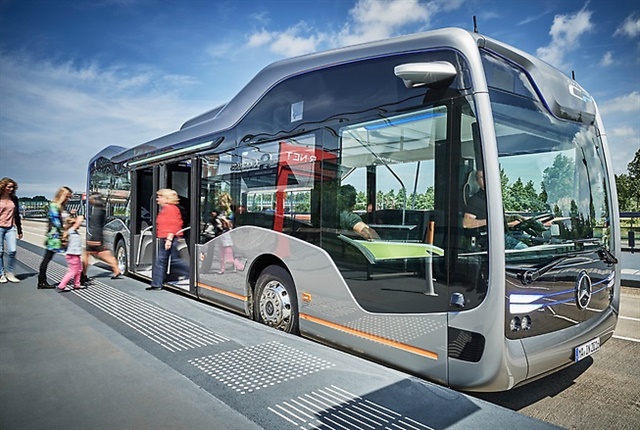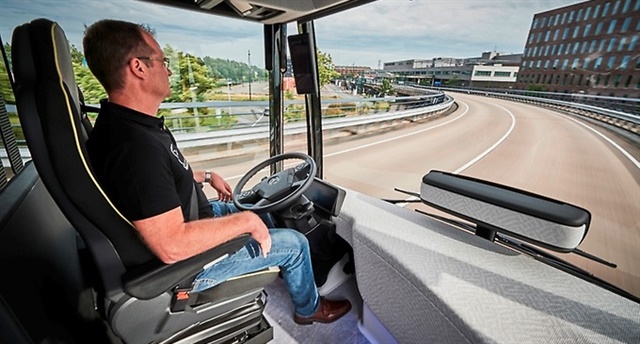Autonomous Truck Development Marches On
The Mercedes-Benz Future Bus is Daimler’s latest entry into the autonomous commercial vehicle realm.
“>
The Mercedes-Benz Future Bus is Daimler’s latest entry into the autonomous commercial vehicle realm.
“>
It’s been an interesting news week on the autonomous commercial vehicle front.
Tesla founder Elon Musk, apparently unfazed by the recent fatal crash involving one of its cars on a beta-test “autopilot” mode and a tractor-trailer (or perhaps wanting to provide a distraction from the bad press), revealed a “master plan” that includes trucks, buses and ride sharing.
In a blog posted on the automaker’s website, he says heavy-duty electric trucks are in the early stages of development and should be ready for unveiling next year.
“We believe the Tesla Semi will deliver a substantial reduction in the cost of cargo transport, while increasing safety and making it really fun to operate.”
He also writes that “as the technology matures, all Tesla vehicles will have the hardware necessary to be fully self-driving with fail-operational capability.”
He cautions, however, that autonomy is still in its early stages.
“It is important to emphasize that refinement and validation of the software will take much longer than putting in place the cameras, radar, sonar and computing hardware … Even once the software is highly refined and far better than the average human driver, there will still be a significant time gap, varying widely by jurisdiction, before true self-driving is approved by regulators.”
Musk said he expects it will take some 6 billion miles of experience with this technology before you see worldwide regulatory approval. Currently we’re accumulating that experience at just over 3 million miles a day, he noted.
So why is Tesla deploying partial autonomy now?
“The most important reason is that, when used correctly, it is already significantly safer than a person driving by themselves, and it would therefore be morally reprehensible to delay release simply for fear of bad press or some mercantile calculation of legal liability.
“According to the recently released 2015 NHTSA report, automotive fatalities increased by 8% to one death every 89 million miles. Autopilot miles will soon exceed twice that number and the system gets better every day. It would no more make sense to disable Tesla’s Autopilot, as some have called for, than it would to disable autopilot in aircraft, after which our system is named.”

On the other side of the Atlantic, Daimler, after testing autonomous technology on commercial trucks in Europe and the U.S. with HighwayPilot, unveiled a semi-automated city bus with CityPilot, touting it as the face of urban public transport of the future.
The technology of the CityPilot in the Mercedes-Benz Future Bus is based on that of the autonomously driving Mercedes-Benz Actros truck with Highway Pilot presented two years ago. It has however undergone substantial further development specifically for use in a city bus. It can recognize traffic lights, communicate with them and safely negotiate junctions controlled by them. It can also recognize obstacles, especially pedestrians on the road, and brake autonomously. It approaches bus stops automatically, where it opens and closes its doors.
Just under a dozen cameras scan the road and surroundings, while long and short-range radar systems constantly monitor the route ahead. There is also a GPS system. All the data received create an extremely precise picture and allow the bus to be positioned to within centimeters. The world premiere of the CityPilot took the bus on an exacting route covering almost 20 km, with a number of tight bends, tunnels, numerous bus stops, and high speeds for a city bus.
Meanwhile, Transportation Secretary Anthony Foxx told an industry conference that the Department of Transportation will issue guidelines this summer on self-driving cars. I’m assuming that these guidelines will either also cover autonomous trucks, or that they will provide a framework for separate guidelines for commercial vehicles.
“We want people who start a trip to finish it,” Foxx said, according to published reports, speaking at the fifth annual Automated Vehicle Symposium in San Francisco.
While the DOT has been working with companies that are developing automated vehicles to adapt existing safety rules to these new technology, Foxx said those existing rules are not enough.
According to the Los Angeles Times, Foxx hinted that those guidelines would involve “pre-market approval steps” for autonomous car technology. But, the paper said, he also emphasized the approach would be flexible, with input from businesses, drivers and technology experts.
“We need clear lines of responsibility between industry, government and consumers,” he said.
Foxx acknowledged that “autonomous vehicles are coming,” whether the world is “ready or not,” reported Fortune.com, which also quoted him as saying:
“We don’t want to replace crashes with human factors with large numbers of crashes caused by systems.” While there are many reasons why the industry is moving toward autonomous vehicles, he said, “if safety isn’t at the very top of the list, we’re not going to get very far.”
Follow @HDTrucking on Twitter
